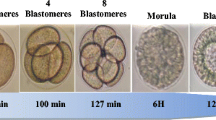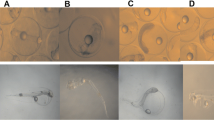Abstract
This study examined the effects of exposing the eggs of the purple sea urchin (Arbacia punctulata) to two commercial polychlorinated biphenyl mixtures (PCB's), Aroclors 1254 and 1016, on fertilization through pluteus (larva) development. Eggs were exposed to various concentrations of the PCB's (0.5, 1.0, 5.0, and 10.0 mg L−1) beginning 25 min prior to insemination, with continuous exposure post-insemination for the 72 hr observation period employed in this study. The PCB's were administered as a component of a filtered sea water (FSW) medium. A FSW control and a FSW-acetone conditioned control where used since acetone was utilized in a 49 : 1, acetone: PCB ratio, to emulsify the PCB's. Since Arbacia eggs cleave synchronously following insemination, the percentage of the eggs cleaving at 1.75 hr post-insemination was used to determine the fertilization efficiency. Pluteus development and morphology was assayed at 24 hr intervals. The results of the fertilization efficiency studies were tested using Chi square and Pearson's-Product-Moment-Correlation Coefficient (r) at a 95% level of confidence. The morphology data were treated with a two-tailed t-test (99% confidence level) and (r). Both PCB's affected fertilization efficiency with the Aroclor 1016 being an order of magnitude more toxic than the Aroclor 1254. Likewise, both Aroclors were toxic to the pluteus development process with Aroclor 1016 being the more toxic of the two mixtures. At the highest PCB level employed, Aroclor 1254 proved more lethally toxic than Aroclor 1016 although both treatment-groups exhibited more than 90% toxicity to the morphogenic process.
Similar content being viewed by others
References
Adams, J. A. and Lawson, W. G., Jr.: 1981, J. Tenn. Acad. Sci. 56, 119.
Adams, J. A.: 1983, Water, Air, and Soil Pollut. 20, 1.
Adams, J. A. and Haileselassie, H. M.: 1984, Arch. Environ. Contam. Toxicol. 13, 493.
DeLong, R. L., Gilmartin, W. G., and Simpson, J. G.: 1973, Science 181, 1168.
Duke, T. W., Lowe, J. I., and Wilson, A. J., Jr.: 1970, Bull. Environ. Contam. Toxicol. 5, 171.
Halter, M. T. and Johnson, H. E.: 1974, J. Fish. Res. Board Canada 31, 1543.
Hansen, L. G., Beyerly, C. S., Metcalf, R. L., and Beville, R. F.: 1975, Am. J. Vet. Res. 36, 23.
Hara, I.: 1985, Environ. Health Perspec. 59, 85.
Harvey, E. B.: 1953, Biol. Bull. 105, 365.
Just, E. E.: 1939, Basic Methods of Experimentation on Eggs of Marine Animals, P. Blankiston, Son, and Co., Inc., Philadelphia.
Kasza, L., Weinberger, M. A., Carter, C., Hinton, D. E., Trump, B. F., and Bouwer, E. A.: 1976, J. Toxicol. Environ. Health. 1, 689.
Kimbrough, R. D.: 1980, Halogenated Biphenyls, Terphenyls, Napthalenes, Dibenzodioxins, and Related Products, Elsevier/North-Holland Biomed. Press, Amsterdam.
Koch, R. B., Desaiah, D., Yap, H. H., and Cutcomp, L.: 1972, Bull. Environ. Conam. Toxicol. 7, 87.
Kriess, K., Zack, M., Kimbrough, R., Needham, L., Smrek, A., and Jones, B.: 1981, JAMA 245, 2505.
Linder, R. E., Gaines, T. B., and Kimbrough, R. D.: 1974, Fd. Cosmet. Toxicol. 12, 63.
Lowe, J. I., Parrish, P. R., Patrick, J. M. Jr., and Forester, J.: 1972, Marine Biol. 17, 209.
Maki, A. W. and Johnson, H. E.: 1973, Bull. Environ. Cotam. Toxicol. 13, 412.
Miyata, H., Fukushima, S., Kashimoto, T., and Kunita, N.: 1985, Environ. Health Perspec. 59, 67.
Nagayama, J., Kiyohara, C., Masuda, Y., and Kuratsune, M.: 1985, Environ. Health Perspec. 59, 107.
Nebeker, A. V. and Puglisi, F. A.: 1974 Trans. Amer. Fish. Soc. 4, 721.
Oerberg, J. and Kihlstronm, J. E.: 1973, Environ. Res. 6, 176.
Oerberg, J., Johanson, N. J., Kihlstronm, J. E., and Lundberg, C.: 1972, Ambio 1, 148.
Rinsky, A. and Perry, A. S.: 1981, Pesticide Biochem. Physiol. 16, 72.
Risenbrough, R. and Brodine, V.: 1970, Environment 12, 16.
Yoshimura, Y., Yoshimura, S., Koga, N., Nagata, K., Wada, I., Kurok, J., and Hokama, Y.: 1985, Environ. Health Perspec. 59, 113.
Author information
Authors and Affiliations
Additional information
Author for all correspondence.
Rights and permissions
About this article
Cite this article
Adams, J.A., Slaughter-Williams, S. The effects of PCB's (Aroclors 1254 and 1016) on fertilization and morphology in Arbacia punctulata . Water Air Soil Pollut 38, 299–310 (1988). https://doi.org/10.1007/BF00280761
Received:
Revised:
Issue Date:
DOI: https://doi.org/10.1007/BF00280761




